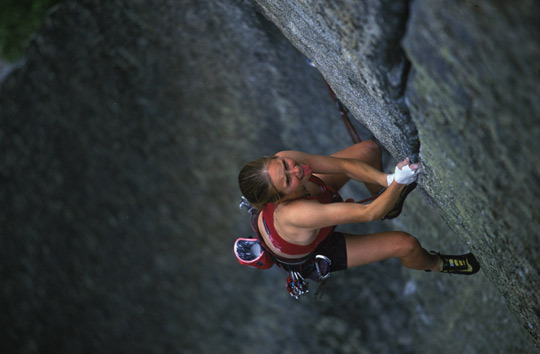One of the best feelings in climbing is walking up to a piece of rock and climbing it onsight, going from the ground to the top without falling and without any knowledge of the route. Onsight climbing, though the ideal style, is one of the hardest parts of climbing to master as it involves solid mental and physical strength. There are a few things that can help with your next onsight.

Beth Rodden on her impressive onsight of The Phoenix a 5.13 crack in Yosemite
Warm-Up Well
Anytime you want to climb at or near your limit, you should engage in a solid warm-up. This is especially true of onsight climbing. Often climbers jump onto hard routes only to be shut down by getting flash pumped, having an excessive amount of lactic acid in your forearms. Climbing a few moderate routes and a route that’s close to but slightly below your onsight level will help warm you up.
Study the Route
There’s only one chance to onsight a route so take the time to study what’s involved. Having experience climbing other routes nearby can help immensely as you’ll be able to find holds better. Examine the route for rests, for obvious tricky sections, for loose rock, hard to place gear or difficult clips. Study the route from three different view points to see all that you can.
While you’re climbing take master onsight climber, Hazel Findlay’s advice, “Have wide eyes and a long neck.” Move your eyes in slow arcs from lower left to lower right. Take in as much as you can and strain your neck to make sure you can see everything. Seeing a hold can make the difference between sending and falling.
Pro-climber Joe Kinder added some solid advice. “Choose a level you can foresee doing and try them at a cliff that offers a lot of that grade and style.”
Go For It
Before committing, make sure the landing is safe, that the gear is solid or the bolts are good and then hold nothing back. Onsighting requires a do or die mentality. Push through questionable sequences with solid confidence that you will send. “Commit to movements and climb fast,” said Emily Harrington who has onsighted 5.13c in the US and in Spain. “It’s a balance between solving the puzzle in the most efficient way and being able to follow your instincts. You don’t want to rush and blow it when there’s a way easier solution, but you also don’t want to mess around climbing up and down trying to figure out a sequence when really all you need to do is commit.” Assume that you’re climbing the route correctly. Confidence goes a long way towards success.
Practice
“Try it more and more,” says Kinder, who offers some of the best advice. The best way to get better at onsight climbing is to do it more. Travel between the gyms in the Bay Area, head to every different crag you can. The more you travel, the more experience you have and the more opportunities you’ll have to onsight different routes.

